Comprehensive Analysis of SAHMRI Project Management Strategies
VerifiedAdded on 2023/01/19
|11
|2956
|55
Report
AI Summary
This report provides a comprehensive analysis of the project management strategies employed by the South Australian Health and Medical Research Institute (SAHMRI). Part A utilizes a PESTEL analysis to examine the political, economic, social, technological, environmental, and legal factors influencing SAHMRI's projects. Part B assesses project viability, outlining decisions needed for feasibility, including preliminary analysis, income projections, market surveys, and risk assessment. Part C delves into project planning, detailing the roles of value management, risk management, quality management, change management, environmental management, health and safety management, and resource management within construction projects. The report emphasizes the importance of these management strategies for successful project outcomes, including the need for quality standards, adequate resources, and continuous feedback to ensure project success. The report also focuses on the importance of financial and time planning for a project of this scale.
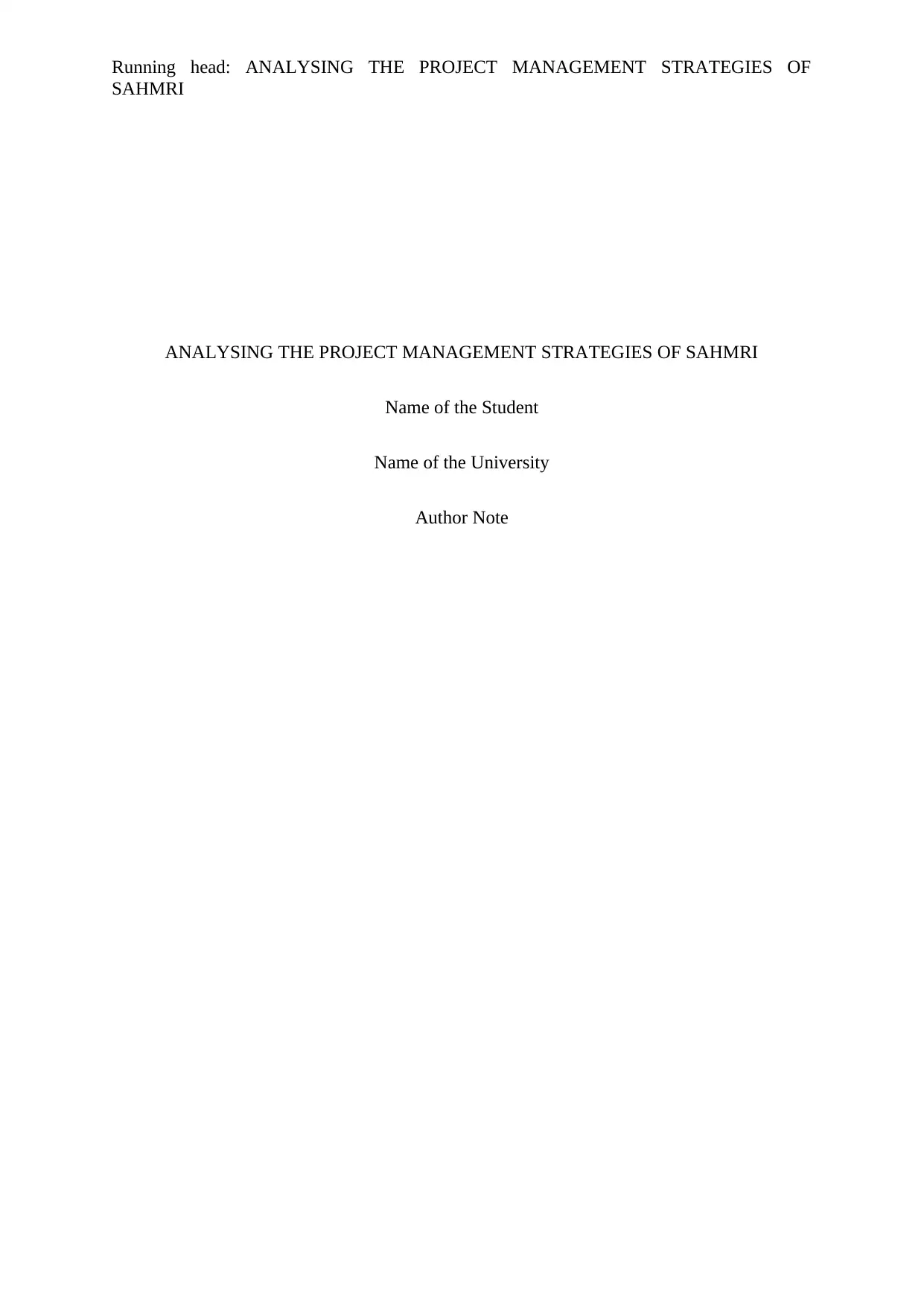
Running head: ANALYSING THE PROJECT MANAGEMENT STRATEGIES OF
SAHMRI
ANALYSING THE PROJECT MANAGEMENT STRATEGIES OF SAHMRI
Name of the Student
Name of the University
Author Note
SAHMRI
ANALYSING THE PROJECT MANAGEMENT STRATEGIES OF SAHMRI
Name of the Student
Name of the University
Author Note
Paraphrase This Document
Need a fresh take? Get an instant paraphrase of this document with our AI Paraphraser
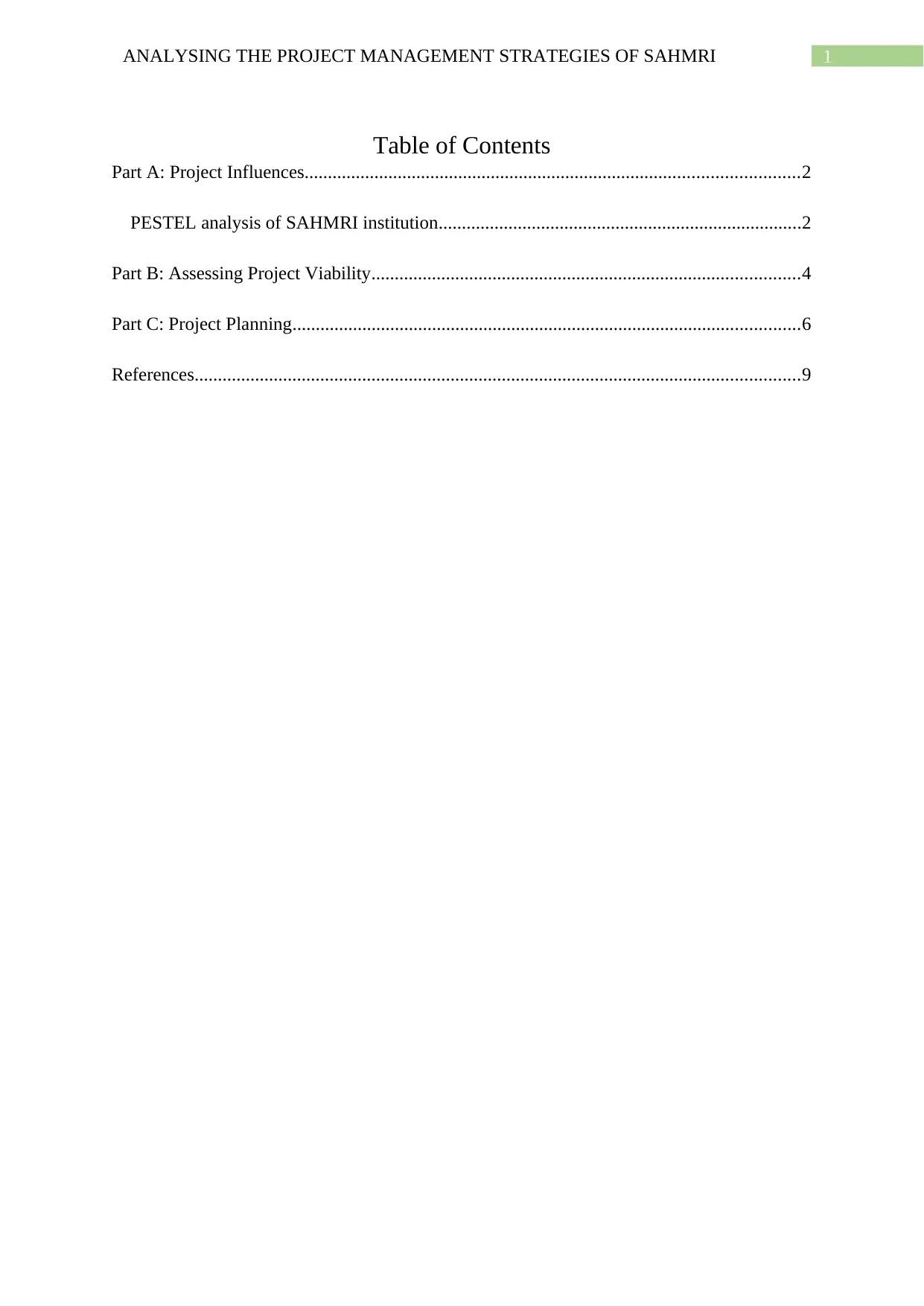
1ANALYSING THE PROJECT MANAGEMENT STRATEGIES OF SAHMRI
Table of Contents
Part A: Project Influences..........................................................................................................2
PESTEL analysis of SAHMRI institution..............................................................................2
Part B: Assessing Project Viability............................................................................................4
Part C: Project Planning.............................................................................................................6
References..................................................................................................................................9
Table of Contents
Part A: Project Influences..........................................................................................................2
PESTEL analysis of SAHMRI institution..............................................................................2
Part B: Assessing Project Viability............................................................................................4
Part C: Project Planning.............................................................................................................6
References..................................................................................................................................9
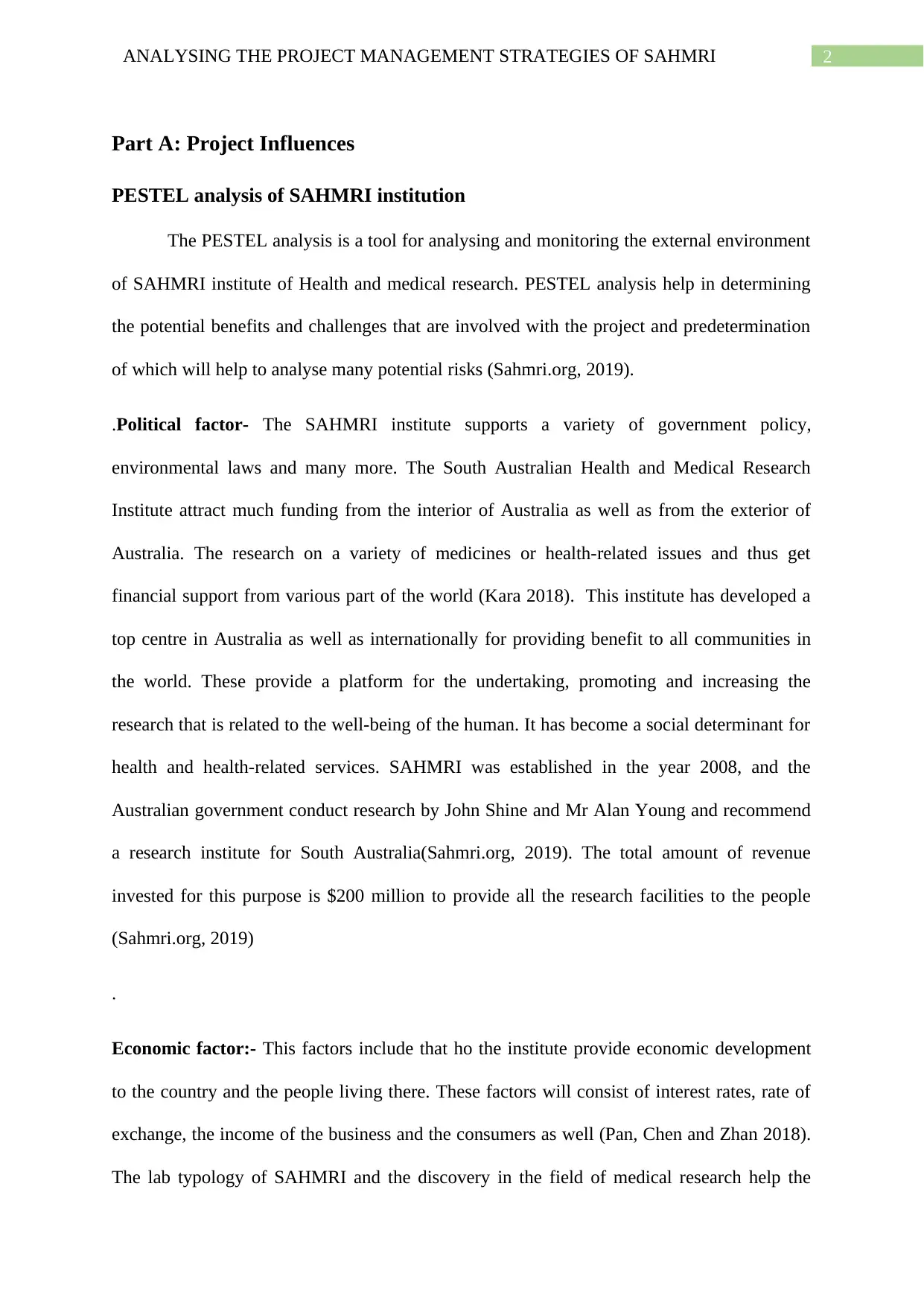
2ANALYSING THE PROJECT MANAGEMENT STRATEGIES OF SAHMRI
Part A: Project Influences
PESTEL analysis of SAHMRI institution
The PESTEL analysis is a tool for analysing and monitoring the external environment
of SAHMRI institute of Health and medical research. PESTEL analysis help in determining
the potential benefits and challenges that are involved with the project and predetermination
of which will help to analyse many potential risks (Sahmri.org, 2019).
.Political factor- The SAHMRI institute supports a variety of government policy,
environmental laws and many more. The South Australian Health and Medical Research
Institute attract much funding from the interior of Australia as well as from the exterior of
Australia. The research on a variety of medicines or health-related issues and thus get
financial support from various part of the world (Kara 2018). This institute has developed a
top centre in Australia as well as internationally for providing benefit to all communities in
the world. These provide a platform for the undertaking, promoting and increasing the
research that is related to the well-being of the human. It has become a social determinant for
health and health-related services. SAHMRI was established in the year 2008, and the
Australian government conduct research by John Shine and Mr Alan Young and recommend
a research institute for South Australia(Sahmri.org, 2019). The total amount of revenue
invested for this purpose is $200 million to provide all the research facilities to the people
(Sahmri.org, 2019)
.
Economic factor:- This factors include that ho the institute provide economic development
to the country and the people living there. These factors will consist of interest rates, rate of
exchange, the income of the business and the consumers as well (Pan, Chen and Zhan 2018).
The lab typology of SAHMRI and the discovery in the field of medical research help the
Part A: Project Influences
PESTEL analysis of SAHMRI institution
The PESTEL analysis is a tool for analysing and monitoring the external environment
of SAHMRI institute of Health and medical research. PESTEL analysis help in determining
the potential benefits and challenges that are involved with the project and predetermination
of which will help to analyse many potential risks (Sahmri.org, 2019).
.Political factor- The SAHMRI institute supports a variety of government policy,
environmental laws and many more. The South Australian Health and Medical Research
Institute attract much funding from the interior of Australia as well as from the exterior of
Australia. The research on a variety of medicines or health-related issues and thus get
financial support from various part of the world (Kara 2018). This institute has developed a
top centre in Australia as well as internationally for providing benefit to all communities in
the world. These provide a platform for the undertaking, promoting and increasing the
research that is related to the well-being of the human. It has become a social determinant for
health and health-related services. SAHMRI was established in the year 2008, and the
Australian government conduct research by John Shine and Mr Alan Young and recommend
a research institute for South Australia(Sahmri.org, 2019). The total amount of revenue
invested for this purpose is $200 million to provide all the research facilities to the people
(Sahmri.org, 2019)
.
Economic factor:- This factors include that ho the institute provide economic development
to the country and the people living there. These factors will consist of interest rates, rate of
exchange, the income of the business and the consumers as well (Pan, Chen and Zhan 2018).
The lab typology of SAHMRI and the discovery in the field of medical research help the
⊘ This is a preview!⊘
Do you want full access?
Subscribe today to unlock all pages.

Trusted by 1+ million students worldwide
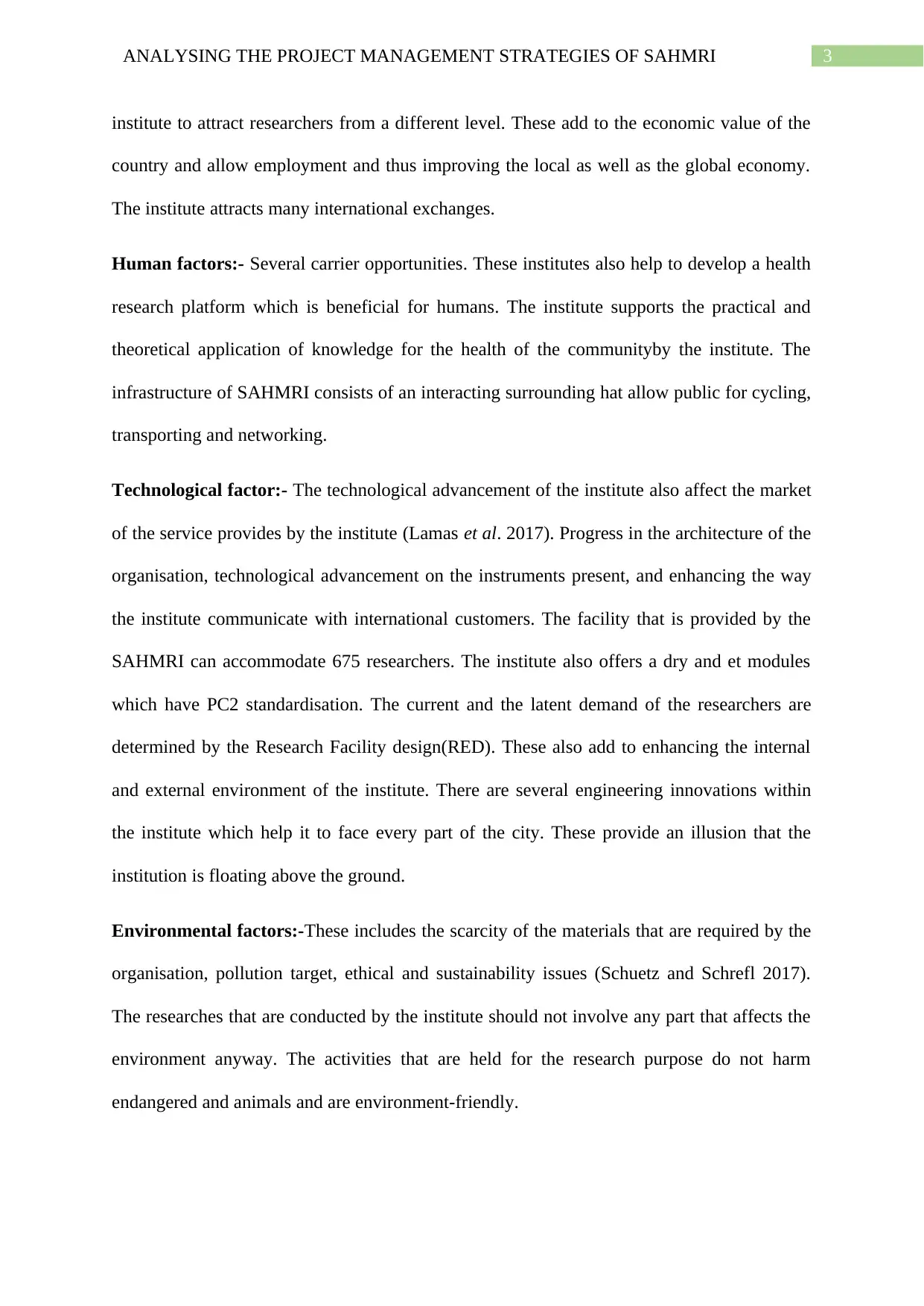
3ANALYSING THE PROJECT MANAGEMENT STRATEGIES OF SAHMRI
institute to attract researchers from a different level. These add to the economic value of the
country and allow employment and thus improving the local as well as the global economy.
The institute attracts many international exchanges.
Human factors:- Several carrier opportunities. These institutes also help to develop a health
research platform which is beneficial for humans. The institute supports the practical and
theoretical application of knowledge for the health of the communityby the institute. The
infrastructure of SAHMRI consists of an interacting surrounding hat allow public for cycling,
transporting and networking.
Technological factor:- The technological advancement of the institute also affect the market
of the service provides by the institute (Lamas et al. 2017). Progress in the architecture of the
organisation, technological advancement on the instruments present, and enhancing the way
the institute communicate with international customers. The facility that is provided by the
SAHMRI can accommodate 675 researchers. The institute also offers a dry and et modules
which have PC2 standardisation. The current and the latent demand of the researchers are
determined by the Research Facility design(RED). These also add to enhancing the internal
and external environment of the institute. There are several engineering innovations within
the institute which help it to face every part of the city. These provide an illusion that the
institution is floating above the ground.
Environmental factors:-These includes the scarcity of the materials that are required by the
organisation, pollution target, ethical and sustainability issues (Schuetz and Schrefl 2017).
The researches that are conducted by the institute should not involve any part that affects the
environment anyway. The activities that are held for the research purpose do not harm
endangered and animals and are environment-friendly.
institute to attract researchers from a different level. These add to the economic value of the
country and allow employment and thus improving the local as well as the global economy.
The institute attracts many international exchanges.
Human factors:- Several carrier opportunities. These institutes also help to develop a health
research platform which is beneficial for humans. The institute supports the practical and
theoretical application of knowledge for the health of the communityby the institute. The
infrastructure of SAHMRI consists of an interacting surrounding hat allow public for cycling,
transporting and networking.
Technological factor:- The technological advancement of the institute also affect the market
of the service provides by the institute (Lamas et al. 2017). Progress in the architecture of the
organisation, technological advancement on the instruments present, and enhancing the way
the institute communicate with international customers. The facility that is provided by the
SAHMRI can accommodate 675 researchers. The institute also offers a dry and et modules
which have PC2 standardisation. The current and the latent demand of the researchers are
determined by the Research Facility design(RED). These also add to enhancing the internal
and external environment of the institute. There are several engineering innovations within
the institute which help it to face every part of the city. These provide an illusion that the
institution is floating above the ground.
Environmental factors:-These includes the scarcity of the materials that are required by the
organisation, pollution target, ethical and sustainability issues (Schuetz and Schrefl 2017).
The researches that are conducted by the institute should not involve any part that affects the
environment anyway. The activities that are held for the research purpose do not harm
endangered and animals and are environment-friendly.
Paraphrase This Document
Need a fresh take? Get an instant paraphrase of this document with our AI Paraphraser
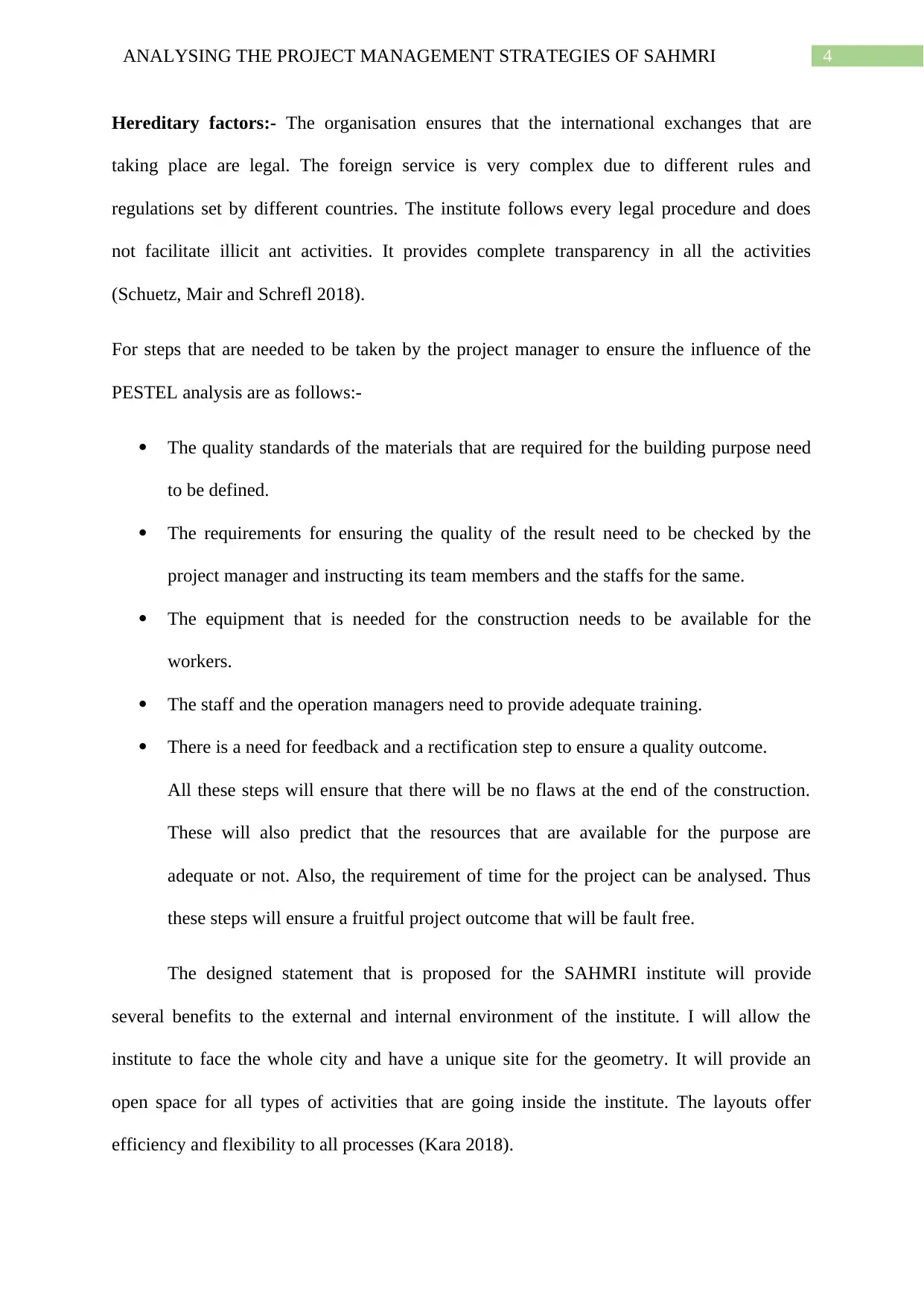
4ANALYSING THE PROJECT MANAGEMENT STRATEGIES OF SAHMRI
Hereditary factors:- The organisation ensures that the international exchanges that are
taking place are legal. The foreign service is very complex due to different rules and
regulations set by different countries. The institute follows every legal procedure and does
not facilitate illicit ant activities. It provides complete transparency in all the activities
(Schuetz, Mair and Schrefl 2018).
For steps that are needed to be taken by the project manager to ensure the influence of the
PESTEL analysis are as follows:-
The quality standards of the materials that are required for the building purpose need
to be defined.
The requirements for ensuring the quality of the result need to be checked by the
project manager and instructing its team members and the staffs for the same.
The equipment that is needed for the construction needs to be available for the
workers.
The staff and the operation managers need to provide adequate training.
There is a need for feedback and a rectification step to ensure a quality outcome.
All these steps will ensure that there will be no flaws at the end of the construction.
These will also predict that the resources that are available for the purpose are
adequate or not. Also, the requirement of time for the project can be analysed. Thus
these steps will ensure a fruitful project outcome that will be fault free.
The designed statement that is proposed for the SAHMRI institute will provide
several benefits to the external and internal environment of the institute. I will allow the
institute to face the whole city and have a unique site for the geometry. It will provide an
open space for all types of activities that are going inside the institute. The layouts offer
efficiency and flexibility to all processes (Kara 2018).
Hereditary factors:- The organisation ensures that the international exchanges that are
taking place are legal. The foreign service is very complex due to different rules and
regulations set by different countries. The institute follows every legal procedure and does
not facilitate illicit ant activities. It provides complete transparency in all the activities
(Schuetz, Mair and Schrefl 2018).
For steps that are needed to be taken by the project manager to ensure the influence of the
PESTEL analysis are as follows:-
The quality standards of the materials that are required for the building purpose need
to be defined.
The requirements for ensuring the quality of the result need to be checked by the
project manager and instructing its team members and the staffs for the same.
The equipment that is needed for the construction needs to be available for the
workers.
The staff and the operation managers need to provide adequate training.
There is a need for feedback and a rectification step to ensure a quality outcome.
All these steps will ensure that there will be no flaws at the end of the construction.
These will also predict that the resources that are available for the purpose are
adequate or not. Also, the requirement of time for the project can be analysed. Thus
these steps will ensure a fruitful project outcome that will be fault free.
The designed statement that is proposed for the SAHMRI institute will provide
several benefits to the external and internal environment of the institute. I will allow the
institute to face the whole city and have a unique site for the geometry. It will provide an
open space for all types of activities that are going inside the institute. The layouts offer
efficiency and flexibility to all processes (Kara 2018).
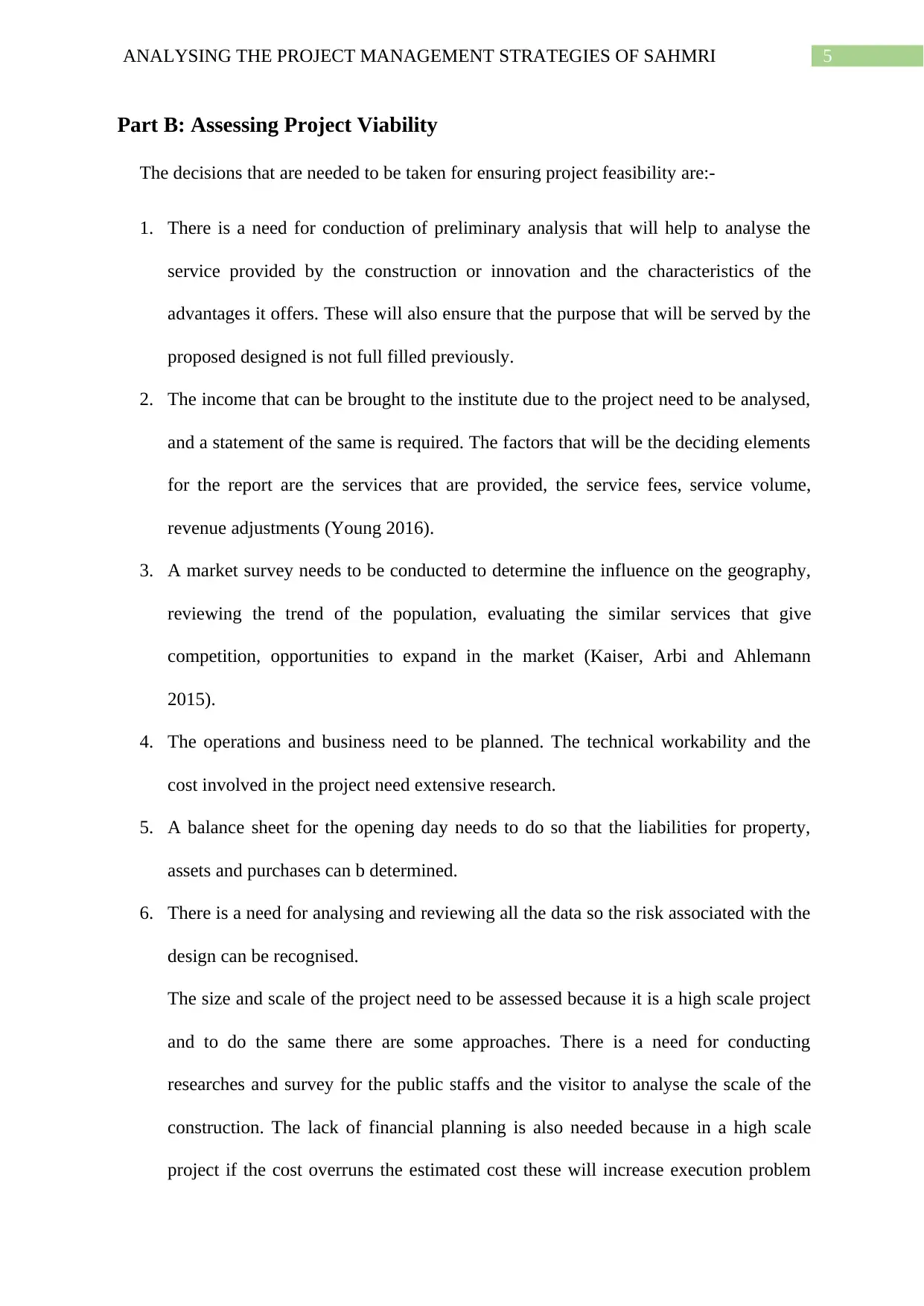
5ANALYSING THE PROJECT MANAGEMENT STRATEGIES OF SAHMRI
Part B: Assessing Project Viability
The decisions that are needed to be taken for ensuring project feasibility are:-
1. There is a need for conduction of preliminary analysis that will help to analyse the
service provided by the construction or innovation and the characteristics of the
advantages it offers. These will also ensure that the purpose that will be served by the
proposed designed is not full filled previously.
2. The income that can be brought to the institute due to the project need to be analysed,
and a statement of the same is required. The factors that will be the deciding elements
for the report are the services that are provided, the service fees, service volume,
revenue adjustments (Young 2016).
3. A market survey needs to be conducted to determine the influence on the geography,
reviewing the trend of the population, evaluating the similar services that give
competition, opportunities to expand in the market (Kaiser, Arbi and Ahlemann
2015).
4. The operations and business need to be planned. The technical workability and the
cost involved in the project need extensive research.
5. A balance sheet for the opening day needs to do so that the liabilities for property,
assets and purchases can b determined.
6. There is a need for analysing and reviewing all the data so the risk associated with the
design can be recognised.
The size and scale of the project need to be assessed because it is a high scale project
and to do the same there are some approaches. There is a need for conducting
researches and survey for the public staffs and the visitor to analyse the scale of the
construction. The lack of financial planning is also needed because in a high scale
project if the cost overruns the estimated cost these will increase execution problem
Part B: Assessing Project Viability
The decisions that are needed to be taken for ensuring project feasibility are:-
1. There is a need for conduction of preliminary analysis that will help to analyse the
service provided by the construction or innovation and the characteristics of the
advantages it offers. These will also ensure that the purpose that will be served by the
proposed designed is not full filled previously.
2. The income that can be brought to the institute due to the project need to be analysed,
and a statement of the same is required. The factors that will be the deciding elements
for the report are the services that are provided, the service fees, service volume,
revenue adjustments (Young 2016).
3. A market survey needs to be conducted to determine the influence on the geography,
reviewing the trend of the population, evaluating the similar services that give
competition, opportunities to expand in the market (Kaiser, Arbi and Ahlemann
2015).
4. The operations and business need to be planned. The technical workability and the
cost involved in the project need extensive research.
5. A balance sheet for the opening day needs to do so that the liabilities for property,
assets and purchases can b determined.
6. There is a need for analysing and reviewing all the data so the risk associated with the
design can be recognised.
The size and scale of the project need to be assessed because it is a high scale project
and to do the same there are some approaches. There is a need for conducting
researches and survey for the public staffs and the visitor to analyse the scale of the
construction. The lack of financial planning is also needed because in a high scale
project if the cost overruns the estimated cost these will increase execution problem
⊘ This is a preview!⊘
Do you want full access?
Subscribe today to unlock all pages.

Trusted by 1+ million students worldwide
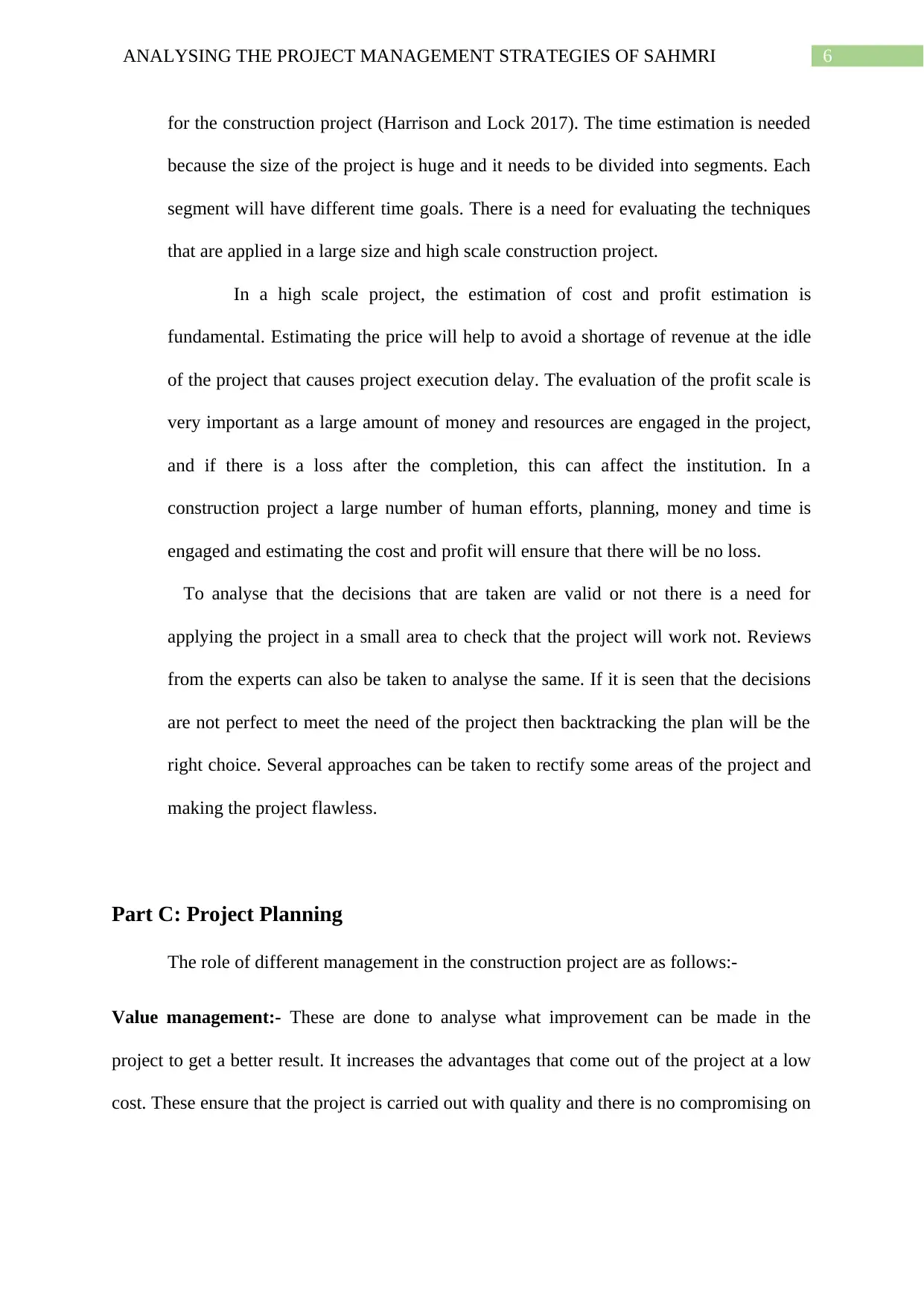
6ANALYSING THE PROJECT MANAGEMENT STRATEGIES OF SAHMRI
for the construction project (Harrison and Lock 2017). The time estimation is needed
because the size of the project is huge and it needs to be divided into segments. Each
segment will have different time goals. There is a need for evaluating the techniques
that are applied in a large size and high scale construction project.
In a high scale project, the estimation of cost and profit estimation is
fundamental. Estimating the price will help to avoid a shortage of revenue at the idle
of the project that causes project execution delay. The evaluation of the profit scale is
very important as a large amount of money and resources are engaged in the project,
and if there is a loss after the completion, this can affect the institution. In a
construction project a large number of human efforts, planning, money and time is
engaged and estimating the cost and profit will ensure that there will be no loss.
To analyse that the decisions that are taken are valid or not there is a need for
applying the project in a small area to check that the project will work not. Reviews
from the experts can also be taken to analyse the same. If it is seen that the decisions
are not perfect to meet the need of the project then backtracking the plan will be the
right choice. Several approaches can be taken to rectify some areas of the project and
making the project flawless.
Part C: Project Planning
The role of different management in the construction project are as follows:-
Value management:- These are done to analyse what improvement can be made in the
project to get a better result. It increases the advantages that come out of the project at a low
cost. These ensure that the project is carried out with quality and there is no compromising on
for the construction project (Harrison and Lock 2017). The time estimation is needed
because the size of the project is huge and it needs to be divided into segments. Each
segment will have different time goals. There is a need for evaluating the techniques
that are applied in a large size and high scale construction project.
In a high scale project, the estimation of cost and profit estimation is
fundamental. Estimating the price will help to avoid a shortage of revenue at the idle
of the project that causes project execution delay. The evaluation of the profit scale is
very important as a large amount of money and resources are engaged in the project,
and if there is a loss after the completion, this can affect the institution. In a
construction project a large number of human efforts, planning, money and time is
engaged and estimating the cost and profit will ensure that there will be no loss.
To analyse that the decisions that are taken are valid or not there is a need for
applying the project in a small area to check that the project will work not. Reviews
from the experts can also be taken to analyse the same. If it is seen that the decisions
are not perfect to meet the need of the project then backtracking the plan will be the
right choice. Several approaches can be taken to rectify some areas of the project and
making the project flawless.
Part C: Project Planning
The role of different management in the construction project are as follows:-
Value management:- These are done to analyse what improvement can be made in the
project to get a better result. It increases the advantages that come out of the project at a low
cost. These ensure that the project is carried out with quality and there is no compromising on
Paraphrase This Document
Need a fresh take? Get an instant paraphrase of this document with our AI Paraphraser
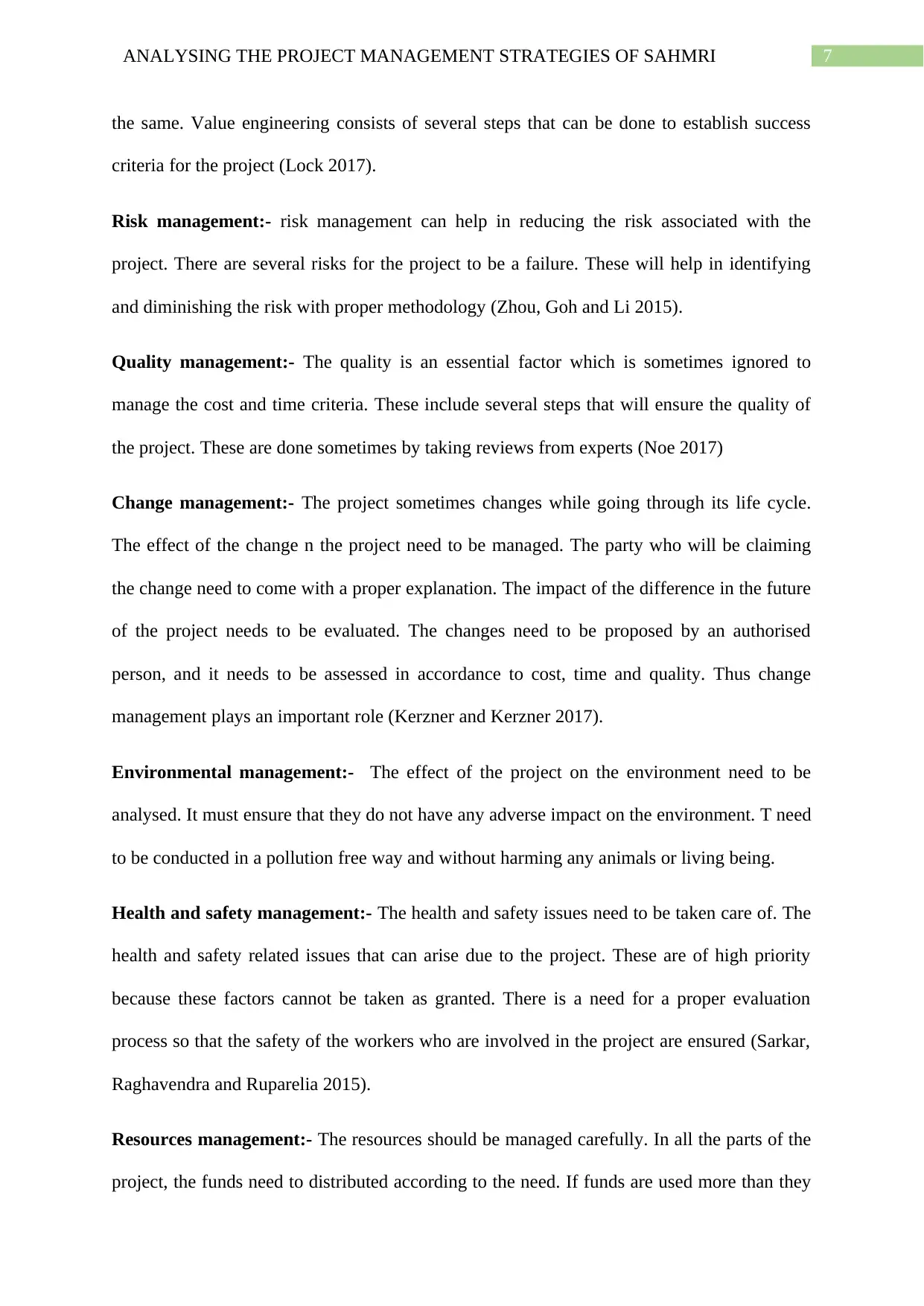
7ANALYSING THE PROJECT MANAGEMENT STRATEGIES OF SAHMRI
the same. Value engineering consists of several steps that can be done to establish success
criteria for the project (Lock 2017).
Risk management:- risk management can help in reducing the risk associated with the
project. There are several risks for the project to be a failure. These will help in identifying
and diminishing the risk with proper methodology (Zhou, Goh and Li 2015).
Quality management:- The quality is an essential factor which is sometimes ignored to
manage the cost and time criteria. These include several steps that will ensure the quality of
the project. These are done sometimes by taking reviews from experts (Noe 2017)
Change management:- The project sometimes changes while going through its life cycle.
The effect of the change n the project need to be managed. The party who will be claiming
the change need to come with a proper explanation. The impact of the difference in the future
of the project needs to be evaluated. The changes need to be proposed by an authorised
person, and it needs to be assessed in accordance to cost, time and quality. Thus change
management plays an important role (Kerzner and Kerzner 2017).
Environmental management:- The effect of the project on the environment need to be
analysed. It must ensure that they do not have any adverse impact on the environment. T need
to be conducted in a pollution free way and without harming any animals or living being.
Health and safety management:- The health and safety issues need to be taken care of. The
health and safety related issues that can arise due to the project. These are of high priority
because these factors cannot be taken as granted. There is a need for a proper evaluation
process so that the safety of the workers who are involved in the project are ensured (Sarkar,
Raghavendra and Ruparelia 2015).
Resources management:- The resources should be managed carefully. In all the parts of the
project, the funds need to distributed according to the need. If funds are used more than they
the same. Value engineering consists of several steps that can be done to establish success
criteria for the project (Lock 2017).
Risk management:- risk management can help in reducing the risk associated with the
project. There are several risks for the project to be a failure. These will help in identifying
and diminishing the risk with proper methodology (Zhou, Goh and Li 2015).
Quality management:- The quality is an essential factor which is sometimes ignored to
manage the cost and time criteria. These include several steps that will ensure the quality of
the project. These are done sometimes by taking reviews from experts (Noe 2017)
Change management:- The project sometimes changes while going through its life cycle.
The effect of the change n the project need to be managed. The party who will be claiming
the change need to come with a proper explanation. The impact of the difference in the future
of the project needs to be evaluated. The changes need to be proposed by an authorised
person, and it needs to be assessed in accordance to cost, time and quality. Thus change
management plays an important role (Kerzner and Kerzner 2017).
Environmental management:- The effect of the project on the environment need to be
analysed. It must ensure that they do not have any adverse impact on the environment. T need
to be conducted in a pollution free way and without harming any animals or living being.
Health and safety management:- The health and safety issues need to be taken care of. The
health and safety related issues that can arise due to the project. These are of high priority
because these factors cannot be taken as granted. There is a need for a proper evaluation
process so that the safety of the workers who are involved in the project are ensured (Sarkar,
Raghavendra and Ruparelia 2015).
Resources management:- The resources should be managed carefully. In all the parts of the
project, the funds need to distributed according to the need. If funds are used more than they
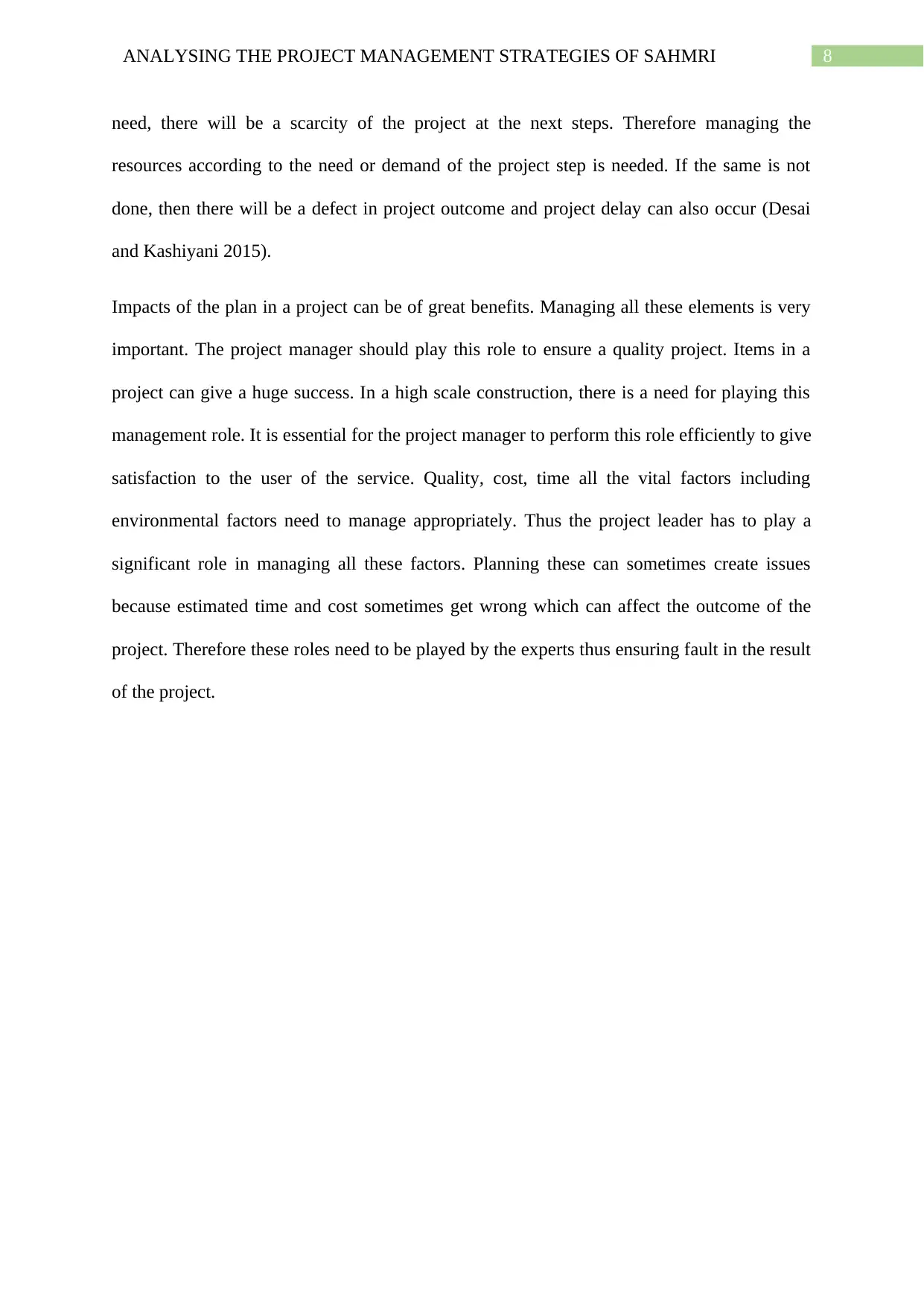
8ANALYSING THE PROJECT MANAGEMENT STRATEGIES OF SAHMRI
need, there will be a scarcity of the project at the next steps. Therefore managing the
resources according to the need or demand of the project step is needed. If the same is not
done, then there will be a defect in project outcome and project delay can also occur (Desai
and Kashiyani 2015).
Impacts of the plan in a project can be of great benefits. Managing all these elements is very
important. The project manager should play this role to ensure a quality project. Items in a
project can give a huge success. In a high scale construction, there is a need for playing this
management role. It is essential for the project manager to perform this role efficiently to give
satisfaction to the user of the service. Quality, cost, time all the vital factors including
environmental factors need to manage appropriately. Thus the project leader has to play a
significant role in managing all these factors. Planning these can sometimes create issues
because estimated time and cost sometimes get wrong which can affect the outcome of the
project. Therefore these roles need to be played by the experts thus ensuring fault in the result
of the project.
need, there will be a scarcity of the project at the next steps. Therefore managing the
resources according to the need or demand of the project step is needed. If the same is not
done, then there will be a defect in project outcome and project delay can also occur (Desai
and Kashiyani 2015).
Impacts of the plan in a project can be of great benefits. Managing all these elements is very
important. The project manager should play this role to ensure a quality project. Items in a
project can give a huge success. In a high scale construction, there is a need for playing this
management role. It is essential for the project manager to perform this role efficiently to give
satisfaction to the user of the service. Quality, cost, time all the vital factors including
environmental factors need to manage appropriately. Thus the project leader has to play a
significant role in managing all these factors. Planning these can sometimes create issues
because estimated time and cost sometimes get wrong which can affect the outcome of the
project. Therefore these roles need to be played by the experts thus ensuring fault in the result
of the project.
⊘ This is a preview!⊘
Do you want full access?
Subscribe today to unlock all pages.

Trusted by 1+ million students worldwide
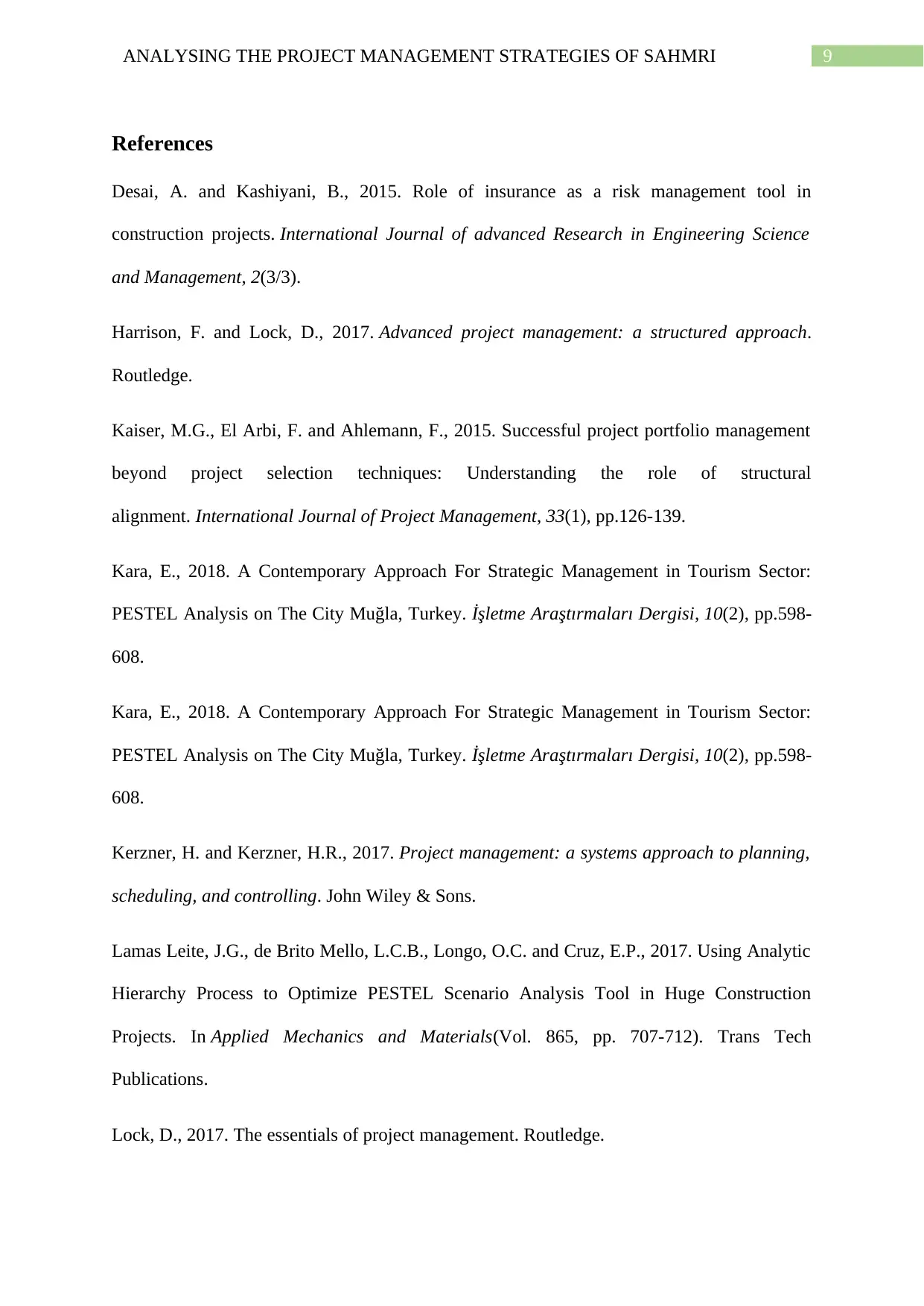
9ANALYSING THE PROJECT MANAGEMENT STRATEGIES OF SAHMRI
References
Desai, A. and Kashiyani, B., 2015. Role of insurance as a risk management tool in
construction projects. International Journal of advanced Research in Engineering Science
and Management, 2(3/3).
Harrison, F. and Lock, D., 2017. Advanced project management: a structured approach.
Routledge.
Kaiser, M.G., El Arbi, F. and Ahlemann, F., 2015. Successful project portfolio management
beyond project selection techniques: Understanding the role of structural
alignment. International Journal of Project Management, 33(1), pp.126-139.
Kara, E., 2018. A Contemporary Approach For Strategic Management in Tourism Sector:
PESTEL Analysis on The City Muğla, Turkey. İşletme Araştırmaları Dergisi, 10(2), pp.598-
608.
Kara, E., 2018. A Contemporary Approach For Strategic Management in Tourism Sector:
PESTEL Analysis on The City Muğla, Turkey. İşletme Araştırmaları Dergisi, 10(2), pp.598-
608.
Kerzner, H. and Kerzner, H.R., 2017. Project management: a systems approach to planning,
scheduling, and controlling. John Wiley & Sons.
Lamas Leite, J.G., de Brito Mello, L.C.B., Longo, O.C. and Cruz, E.P., 2017. Using Analytic
Hierarchy Process to Optimize PESTEL Scenario Analysis Tool in Huge Construction
Projects. In Applied Mechanics and Materials(Vol. 865, pp. 707-712). Trans Tech
Publications.
Lock, D., 2017. The essentials of project management. Routledge.
References
Desai, A. and Kashiyani, B., 2015. Role of insurance as a risk management tool in
construction projects. International Journal of advanced Research in Engineering Science
and Management, 2(3/3).
Harrison, F. and Lock, D., 2017. Advanced project management: a structured approach.
Routledge.
Kaiser, M.G., El Arbi, F. and Ahlemann, F., 2015. Successful project portfolio management
beyond project selection techniques: Understanding the role of structural
alignment. International Journal of Project Management, 33(1), pp.126-139.
Kara, E., 2018. A Contemporary Approach For Strategic Management in Tourism Sector:
PESTEL Analysis on The City Muğla, Turkey. İşletme Araştırmaları Dergisi, 10(2), pp.598-
608.
Kara, E., 2018. A Contemporary Approach For Strategic Management in Tourism Sector:
PESTEL Analysis on The City Muğla, Turkey. İşletme Araştırmaları Dergisi, 10(2), pp.598-
608.
Kerzner, H. and Kerzner, H.R., 2017. Project management: a systems approach to planning,
scheduling, and controlling. John Wiley & Sons.
Lamas Leite, J.G., de Brito Mello, L.C.B., Longo, O.C. and Cruz, E.P., 2017. Using Analytic
Hierarchy Process to Optimize PESTEL Scenario Analysis Tool in Huge Construction
Projects. In Applied Mechanics and Materials(Vol. 865, pp. 707-712). Trans Tech
Publications.
Lock, D., 2017. The essentials of project management. Routledge.
Paraphrase This Document
Need a fresh take? Get an instant paraphrase of this document with our AI Paraphraser
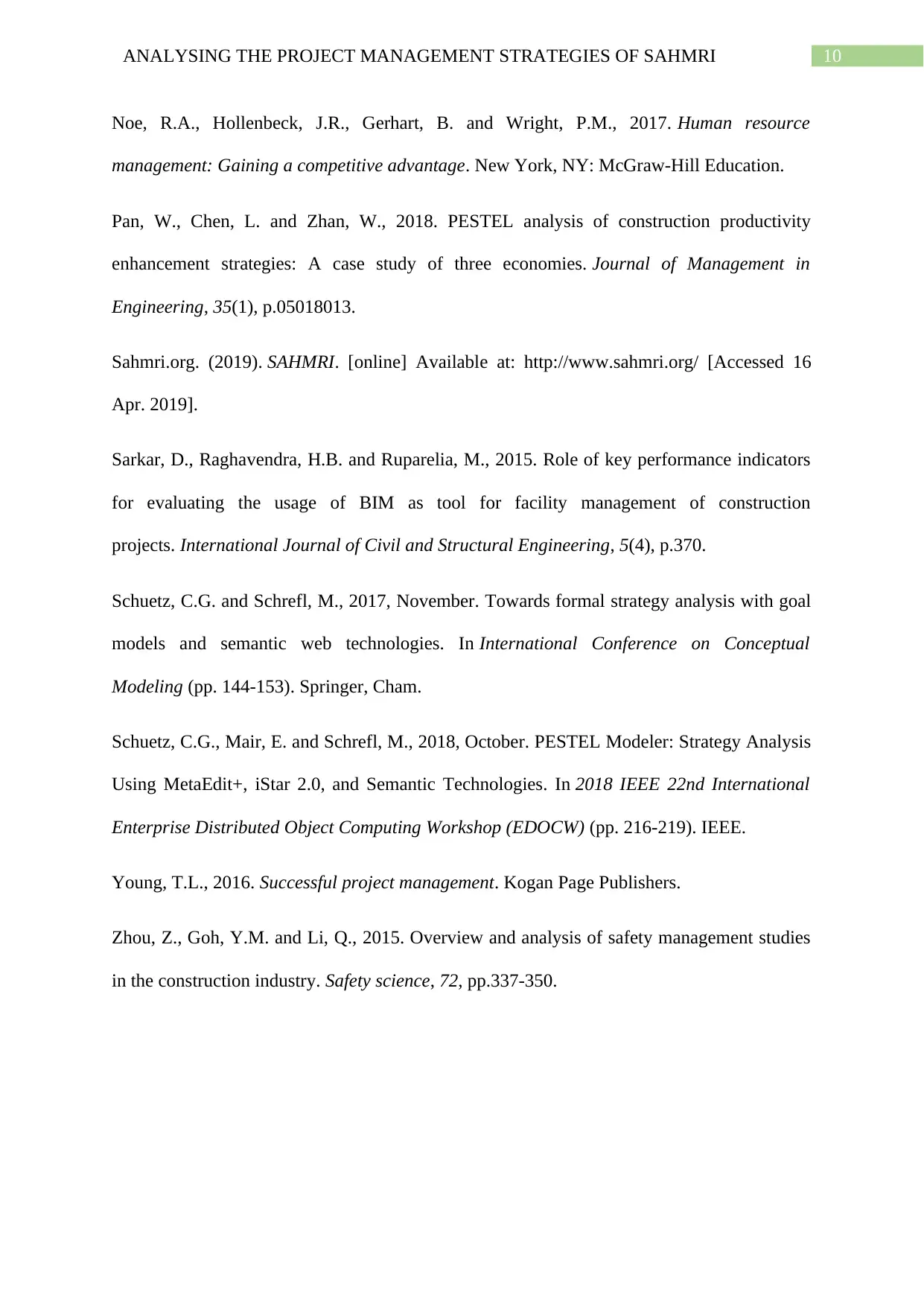
10ANALYSING THE PROJECT MANAGEMENT STRATEGIES OF SAHMRI
Noe, R.A., Hollenbeck, J.R., Gerhart, B. and Wright, P.M., 2017. Human resource
management: Gaining a competitive advantage. New York, NY: McGraw-Hill Education.
Pan, W., Chen, L. and Zhan, W., 2018. PESTEL analysis of construction productivity
enhancement strategies: A case study of three economies. Journal of Management in
Engineering, 35(1), p.05018013.
Sahmri.org. (2019). SAHMRI. [online] Available at: http://www.sahmri.org/ [Accessed 16
Apr. 2019].
Sarkar, D., Raghavendra, H.B. and Ruparelia, M., 2015. Role of key performance indicators
for evaluating the usage of BIM as tool for facility management of construction
projects. International Journal of Civil and Structural Engineering, 5(4), p.370.
Schuetz, C.G. and Schrefl, M., 2017, November. Towards formal strategy analysis with goal
models and semantic web technologies. In International Conference on Conceptual
Modeling (pp. 144-153). Springer, Cham.
Schuetz, C.G., Mair, E. and Schrefl, M., 2018, October. PESTEL Modeler: Strategy Analysis
Using MetaEdit+, iStar 2.0, and Semantic Technologies. In 2018 IEEE 22nd International
Enterprise Distributed Object Computing Workshop (EDOCW) (pp. 216-219). IEEE.
Young, T.L., 2016. Successful project management. Kogan Page Publishers.
Zhou, Z., Goh, Y.M. and Li, Q., 2015. Overview and analysis of safety management studies
in the construction industry. Safety science, 72, pp.337-350.
Noe, R.A., Hollenbeck, J.R., Gerhart, B. and Wright, P.M., 2017. Human resource
management: Gaining a competitive advantage. New York, NY: McGraw-Hill Education.
Pan, W., Chen, L. and Zhan, W., 2018. PESTEL analysis of construction productivity
enhancement strategies: A case study of three economies. Journal of Management in
Engineering, 35(1), p.05018013.
Sahmri.org. (2019). SAHMRI. [online] Available at: http://www.sahmri.org/ [Accessed 16
Apr. 2019].
Sarkar, D., Raghavendra, H.B. and Ruparelia, M., 2015. Role of key performance indicators
for evaluating the usage of BIM as tool for facility management of construction
projects. International Journal of Civil and Structural Engineering, 5(4), p.370.
Schuetz, C.G. and Schrefl, M., 2017, November. Towards formal strategy analysis with goal
models and semantic web technologies. In International Conference on Conceptual
Modeling (pp. 144-153). Springer, Cham.
Schuetz, C.G., Mair, E. and Schrefl, M., 2018, October. PESTEL Modeler: Strategy Analysis
Using MetaEdit+, iStar 2.0, and Semantic Technologies. In 2018 IEEE 22nd International
Enterprise Distributed Object Computing Workshop (EDOCW) (pp. 216-219). IEEE.
Young, T.L., 2016. Successful project management. Kogan Page Publishers.
Zhou, Z., Goh, Y.M. and Li, Q., 2015. Overview and analysis of safety management studies
in the construction industry. Safety science, 72, pp.337-350.
1 out of 11
Related Documents
Your All-in-One AI-Powered Toolkit for Academic Success.
+13062052269
info@desklib.com
Available 24*7 on WhatsApp / Email
![[object Object]](/_next/static/media/star-bottom.7253800d.svg)
Unlock your academic potential
Copyright © 2020–2025 A2Z Services. All Rights Reserved. Developed and managed by ZUCOL.





